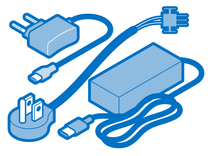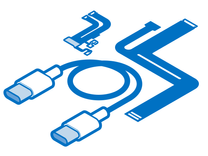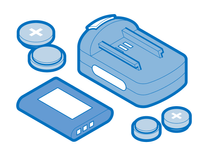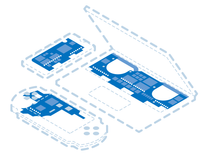The Basics
Before undertaking any of the more time-consuming solutions below, here are a few fundamentals to get you started:
- Restart your computer. It's Troubleshooting 101 for good reason. Restarting your laptop correctly (rather than by crash or boot loop) finalizes any pending repairs and restarts all systems services. Use the restart option in the Start Menu.
- If your computer is getting a "Blue Screen of Death" (BSOD) when it's restarting, check out the Dell Laptop Blue Screen page.
- Force a shutdown. Interrupt a reboot cycle or boot loop by pressing and holding the power button until the device stays off.
- Once you have enforced a shutdown, try and power on again. This kind of reset may clear bunk settings.
- Remove all peripherals. This applies to anything attached to your laptop—flash drives, USB hubs, display cables, dongles, literally anything other than the charger.
- Verify the battery is connected: If your Dell Laptop has a removable battery, ensure it is seated correctly in your laptop and secured.
- Process any pending Windows updates. Updates can resolve software issues with Windows or correct compatibility conflicts.
Causes
Default Windows settings are intended to be best for most people. But hardware (and software) specifics vary wildly across Windows configurations. This diversity has the potential to put a wrench in setting standardization.
- Disable Fast Startup. While it accelerates boot time, it prevents the computer from shutting down completely.
- Press Windows and R to open a Run window.
- In the Run window type powercfg.cpl and press enter.
- On left side of this window, select "Choose what the power button does."
- Click on the Change settings that are currently unavailable option. Provide an administrator password, or agree to allow changes on the admin control prompt.
- Uncheck the Turn on fast startup (recommended) checkbox and save the changes.
A restore point can be used to revert any unwanted changes made resulting in poor performance. This is especially useful if your laptop won't boot into Windows.
Is your laptop restarting more often when you move it around? It could be that power is getting cut due to wiggly connections between the charger and the charger port.
- Try a different charger if you have one to rule this out.
- Check to see if the laptop stays charging when you move it. If not, wiggle the charger input to see if you can recreate the issue.
- Perform a visual inspection of the charger and the charge port. A bent pin, or worn housing can cause inconsistent connection, knocking out the power if it gets moved.
- Replace the charger or cables depending on which component seems to be faulty.

Find compatible replacement parts for your Dell Laptop. All parts and fix kits are backed by the iFixit Quality Guarantee.

Find compatible replacement parts for your Dell Laptop. All parts and fix kits are backed by the iFixit Quality Guarantee.
Any physical component of your computer needs instructions so Windows knows how to use it. That's all a driver is, an instruction manual for Windows. If the instructions are old, they may not be compatible any longer.
- Check for errors in Device Manager. Press the Windows Key and X and select Device Manager from the menu that appears. If an error is present, the collapsed item in the Device tree will be expanded and a yellow caution icon displays for any devices with errors.
- Newer versions of Windows serve most driver updates through standard Windows Update. Right click the Start Menu and select Settings > Update & Security > Windows Update. Click the Check for Update button
- You may need to select "View Optional Updates" to see some additional drivers.
- Use Dell SupportAssist to download drivers from Dell. These are often newer than Windows distributed versions. Microsoft will only push drivers that have been submitted through proper channels.
- The manufacturer of the part may have drivers even more current than Dell's. This is especially relevant for graphics processing. Check, AMD, Intel or NVidia directly.
Avoid any program advertised as a driver updater if it doesn't come directly from an electronics manufacturer (ie. Intel, AMD, Realtek, etc.) or Dell. These can install the incorrect drivers at best or malware at worst.
- If updating doesn't resolve, and you think you know which device is the issue, try uninstalling the driver.
- In Device Manager, find the component you suspect is problematic and right click it. Select Uninstall from this menu. A checkbox should appear in the confirmation window to also uninstall the driver. Be sure to check it.
- After the uninstall is complete, restart your computer and reinstall the current version.
- If the device is graphics related, DDU might help. It assists with clean uninstall of graphics drivers from all manufacturers.
Computer viruses and other harmful software can wreak havoc on system stability. They may generate issues the computer can only correct with a restart.
- Scan your computer using an Antivirus. If you do not have dedicated security software, use Windows Defender. It can be accessed from the Windows Security App in most versions of Windows.
- Want a second opinion about your results? Malwarebytes or ESET Online Scan are free programs that provide some excellent malware scanning techniques.
- There are many free malware removal tools available, but a paid solution will be more effective. Be sure to verify legitimacy before using software from any unfamiliar developer or you may end up worse off than before.
- Remove anything the scan finds. It may also recommend a restart to complete the removal.
- Keep reading through the OS Corruption section and process those fixes as well. Malware can damage Windows as a result of infection.
A corrupt OS means that there are files critical to the operating system that has become invalid or messed up in some way (the computer was powered off during an update, the computer died while sleeping, etc). Windows provides access to repair tools that correct these corruption issues.
- Right-click the Start Menu and select Command Prompt, Powershell, or Windows Terminal (Windows 8, 10, and 11 will provide different options).
- Type sfc /scannow and hit Enter.
- Wait for the command to finish. If there were corrupt files to repair, it would repair them.
- This is just the start. Consult the Basic Windows Repair guide for a more complete list of repair options.
Reinstall Windows. A complete Windows reinstall may be necessary to restore the laptop's normal function.
- Use a known good and "clean" computer to download the Windows operating system to create a bootable flash drive.
- Back up any files, bookmarks, pictures, etc., you wish to keep onto a cloud platform like Google Drive or Dropbox after you have run antivirus scans. This can lessen the transfer of existing malware onto your fresh install of Windows compared to plugging in a flash drive and infecting multiple computers.
- Boot from the Windows bootable flash drive. Erase all partitions in the setup wizard and install the fresh OS to your drive.
- Transfer the data back onto your laptop.

- No estimateModerate
Batteries are nefarious. They often fail due to their “consumable” nature. Although they typically die slowly and with diminishing power on time, a bunk battery might provide inconsistent power, causing unexpected shutdowns, or restarts.
- Run a power diagnostic. Dell's SupportAssist software contains a test for battery health. Or use powrcfg to get a more detailed history. Check the full charge capacity from this report against the design capacity. If numbers are inconsistent, or the max capacity is lower than you'd like, install a new battery.
- Check for visual signs of battery age, swelling, or leak. Swollen batteries may manifest as difficulty using the trackpad or the keyboard. As the battery expands, it exerts upward pressure on the underside of these components.
- Disconnect your battery and run the laptop on only the charger. This way, the charger is doing the heavy lifting. If your restarts stop, replace the battery.
If you find determine your battery is a likely cause, check out the iFixit Dell Laptop battery selection for your exact model and follow along with a guide.
The BIOS on many Dell laptops is prone to rejecting third party batteries. If the system detects a non-Dell battery and the laptop shuts charging down, try disconnecting the battery and reconnecting it, or removing the ACPI Windows driver if it is blocked in Windows.

Find compatible replacement parts for your Dell Laptop. All parts and fix kits are backed by the iFixit Quality Guarantee.
Random Access Memory, more commonly known as RAM is a likely hardware culprit for repeat crashes. Luckily, most models of Dell laptop still contain at least one stick of modular RAM and are generally easy to replace.
- Reseat your RAM modules. There are numerous, tiny pins that could be slightly out of alignment. Removing them and reinstalling might be all it takes to sort this out.
- Test your RAM by running a diagnostic. Dell SupportAssist contains both quick and extended RAM tests, or you can use Windows Memory Diagnostics.
- If you want a second opinion, IT Professionals have been using memtext86 for ages. It's a free tool and their documentation is excellent! But it will require a bit more know how to use.
- RAM tests are notoriously long and minor failures are difficult for tests to find. Trust diagnostic failures, but not passes. Multiple diagnostic runs may be needed to find an issue.
- If you have recently upgraded your RAM and are now getting random restarts, verify compatibility of the installed RAM and your Dell laptop.
- If you have more than one module installed, make sure the specs match. At least speed and capacity should be identical.
- Replace the memory if diagnostics fail—either increasing the overall size or keeping the exact amount and speed.
- Some Dell laptops, especially smaller XPS models, will have the RAM soldered to the board. In this case, you will need to replace the motherboard.
Be especially mindful when replacing RAM to use something that is compatible. Crucial has a compatibility checker for their products you can use to validate.

Find compatible replacement parts for your Dell Laptop. All parts and fix kits are backed by the iFixit Quality Guarantee.

Find compatible replacement parts for your Dell Laptop. All parts and fix kits are backed by the iFixit Quality Guarantee.
If the above tips have failed, the issue might be caused by the motherboard. Damage to the motherboard due to physical trauma, electrical surges, or other hardware-related issues can impact functionality. A faulty motherboard can lead to erratic behavior, intermittent freezing, crashing or overall system instability.
- Check for diagnostic codes. After a restart or crash, you may get additional error codes. The Power LED or CAPS Lock LED will blink in a pattern to designate errors. These are often specific to the line of Dell (ie. XPS, Latitude, Inspiron).
- Older Dell laptops often use beep codes to indicate hardware issues during the boot process. A certain pattern of beeps indicates a specific fault.
- Referencing these codes can identify issues with hardware components already discussed (memory or hard drive), but can also point to CPU, BIOS or other motherboard failures.
- Dell laptops have their CPU soldered to the motherboard. If your blue screen codes point to CPU failure, you'll need to replace the motherboard.
- Inspect the laptop's motherboard for any signs of physical damage, such as burnt components, liquid residue, corrosion, or other visible issues. Replace the board, or consult a pro if you find any damage.
- Circuit boards can often be repaired by a knowledgeable technician with soldering (or microsoldering) experience. Ask your local repair shops if this isn't something you think you could do yourself.

Find compatible replacement parts for your Dell Laptop. All parts and fix kits are backed by the iFixit Quality Guarantee.
You're seeing solutions for Dell Laptop. Select your model to find parts for your device.








